2011年-2016年语音识别方法小结
语音识别技术的原理及其实现方法
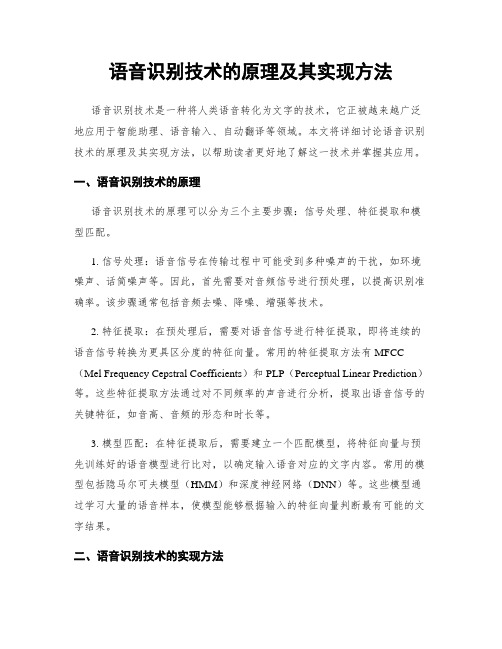
语音识别技术的原理及其实现方法语音识别技术是一种将人类语音转化为文字的技术,它正被越来越广泛地应用于智能助理、语音输入、自动翻译等领域。
本文将详细讨论语音识别技术的原理及其实现方法,以帮助读者更好地了解这一技术并掌握其应用。
一、语音识别技术的原理语音识别技术的原理可以分为三个主要步骤:信号处理、特征提取和模型匹配。
1. 信号处理:语音信号在传输过程中可能受到多种噪声的干扰,如环境噪声、话筒噪声等。
因此,首先需要对音频信号进行预处理,以提高识别准确率。
该步骤通常包括音频去噪、降噪、增强等技术。
2. 特征提取:在预处理后,需要对语音信号进行特征提取,即将连续的语音信号转换为更具区分度的特征向量。
常用的特征提取方法有MFCC (Mel Frequency Cepstral Coefficients)和PLP(Perceptual Linear Prediction)等。
这些特征提取方法通过对不同频率的声音进行分析,提取出语音信号的关键特征,如音高、音频的形态和时长等。
3. 模型匹配:在特征提取后,需要建立一个匹配模型,将特征向量与预先训练好的语音模型进行比对,以确定输入语音对应的文字内容。
常用的模型包括隐马尔可夫模型(HMM)和深度神经网络(DNN)等。
这些模型通过学习大量的语音样本,使模型能够根据输入的特征向量判断最有可能的文字结果。
二、语音识别技术的实现方法语音识别技术的实现需要借助特定的工具和算法。
以下是常用的语音识别技术实现方法:1. 基于统计模型的方法:该方法主要基于隐马尔可夫模型(HMM)和高斯混合模型(GMM)。
隐马尔可夫模型用于描述语音信号的动态性,而高斯混合模型则用于对特征向量进行建模。
这种方法的优点在于其模型简单,容易实现,但其处理长时语音和噪声的能力较弱。
2. 基于神经网络的方法:随着深度学习技术的发展,深度神经网络(DNN)成为语音识别领域的热门技术。
该方法使用多层神经网络模型来学习语音信号的特征表示和模式匹配。
语音识别技术的使用技巧和注意事项
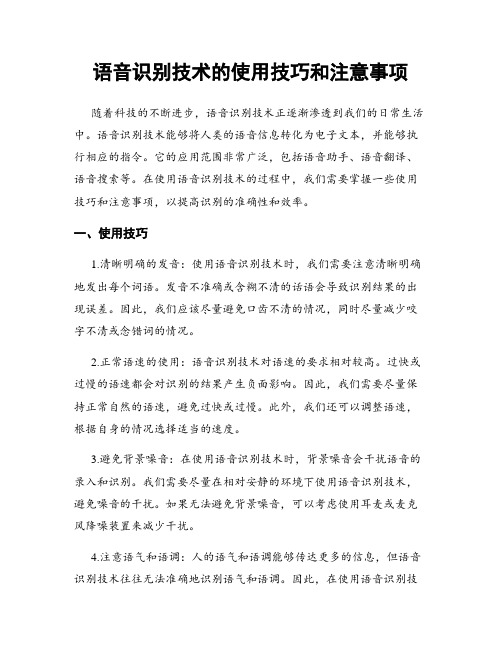
语音识别技术的使用技巧和注意事项随着科技的不断进步,语音识别技术正逐渐渗透到我们的日常生活中。
语音识别技术能够将人类的语音信息转化为电子文本,并能够执行相应的指令。
它的应用范围非常广泛,包括语音助手、语音翻译、语音搜索等。
在使用语音识别技术的过程中,我们需要掌握一些使用技巧和注意事项,以提高识别的准确性和效率。
一、使用技巧1.清晰明确的发音:使用语音识别技术时,我们需要注意清晰明确地发出每个词语。
发音不准确或含糊不清的话语会导致识别结果的出现误差。
因此,我们应该尽量避免口齿不清的情况,同时尽量减少咬字不清或念错词的情况。
2.正常语速的使用:语音识别技术对语速的要求相对较高。
过快或过慢的语速都会对识别的结果产生负面影响。
因此,我们需要尽量保持正常自然的语速,避免过快或过慢。
此外,我们还可以调整语速,根据自身的情况选择适当的速度。
3.避免背景噪音:在使用语音识别技术时,背景噪音会干扰语音的录入和识别。
我们需要尽量在相对安静的环境下使用语音识别技术,避免噪音的干扰。
如果无法避免背景噪音,可以考虑使用耳麦或麦克风降噪装置来减少干扰。
4.注意语气和语调:人的语气和语调能够传达更多的信息,但语音识别技术往往无法准确地识别语气和语调。
因此,在使用语音识别技术时,我们需要尽量避免过于情绪化或夸张的语气和语调,以免影响识别结果的准确性。
5.善用断句和标点:语音识别技术在处理长篇连贯的语音时可能会出现困难,因为它们需要更长的时间来处理长句子。
所以,为了提升语音识别的准确性和效率,我们可以适当地使用断句和标点,让语音识别引擎更容易理解和转化为文字。
二、注意事项1.保护隐私和数据安全:语音识别技术在使用过程中会涉及到用户的语音数据。
为了保护用户的隐私和数据安全,我们需要选择可靠的语音识别服务提供商,并注意该服务商的数据隐私政策。
2.保证网络稳定:使用语音识别技术需要依赖互联网连接。
因此,我们需要确保网络连接的稳定性,避免由于网络不稳定导致的识别错误或中断。
人工智能语音识别算法的使用方法与技巧
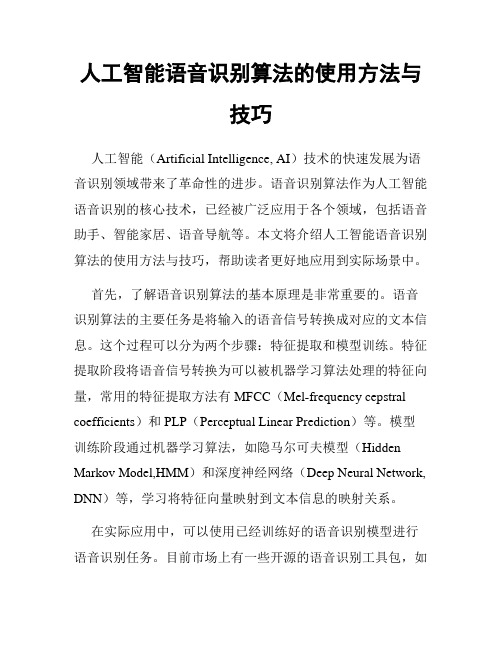
人工智能语音识别算法的使用方法与技巧人工智能(Artificial Intelligence, AI)技术的快速发展为语音识别领域带来了革命性的进步。
语音识别算法作为人工智能语音识别的核心技术,已经被广泛应用于各个领域,包括语音助手、智能家居、语音导航等。
本文将介绍人工智能语音识别算法的使用方法与技巧,帮助读者更好地应用到实际场景中。
首先,了解语音识别算法的基本原理是非常重要的。
语音识别算法的主要任务是将输入的语音信号转换成对应的文本信息。
这个过程可以分为两个步骤:特征提取和模型训练。
特征提取阶段将语音信号转换为可以被机器学习算法处理的特征向量,常用的特征提取方法有MFCC(Mel-frequency cepstral coefficients)和PLP(Perceptual Linear Prediction)等。
模型训练阶段通过机器学习算法,如隐马尔可夫模型(Hidden Markov Model,HMM)和深度神经网络(Deep Neural Network, DNN)等,学习将特征向量映射到文本信息的映射关系。
在实际应用中,可以使用已经训练好的语音识别模型进行语音识别任务。
目前市场上有一些开源的语音识别工具包,如Google的Speech-to-Text API和CMU Sphinx等,可以直接使用已经训练好的模型进行语音识别。
使用这些工具包,只需要准备好语音数据,并按照工具包的使用说明进行配置和调用即可。
然而,如果需要进行更加精确和定制化的语音识别,就需要针对具体的场景和需求自行开发语音识别算法。
以下是几个关键技巧和步骤供参考。
第一,选择适合的语音识别模型。
语音识别模型有多种选择,包括传统的隐马尔可夫模型和深度神经网络。
隐马尔可夫模型在训练过程中需要手动定义状态和状态转移概率,适合于相对简单的语音识别任务。
而深度神经网络则通过大量的训练数据自动学习语音和文本之间的映射关系,适合用于复杂的语音识别任务。
语音识别技术的使用教程和技巧
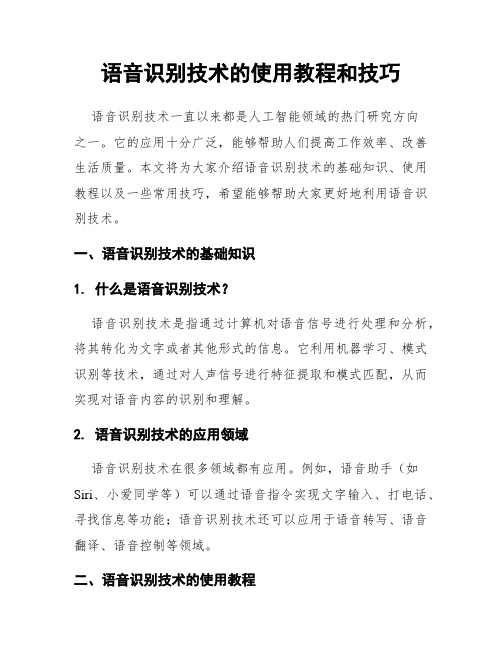
语音识别技术的使用教程和技巧语音识别技术一直以来都是人工智能领域的热门研究方向之一。
它的应用十分广泛,能够帮助人们提高工作效率、改善生活质量。
本文将为大家介绍语音识别技术的基础知识、使用教程以及一些常用技巧,希望能够帮助大家更好地利用语音识别技术。
一、语音识别技术的基础知识1. 什么是语音识别技术?语音识别技术是指通过计算机对语音信号进行处理和分析,将其转化为文字或者其他形式的信息。
它利用机器学习、模式识别等技术,通过对人声信号进行特征提取和模式匹配,从而实现对语音内容的识别和理解。
2. 语音识别技术的应用领域语音识别技术在很多领域都有应用。
例如,语音助手(如Siri、小爱同学等)可以通过语音指令实现文字输入、打电话、寻找信息等功能;语音识别技术还可以应用于语音转写、语音翻译、语音控制等领域。
二、语音识别技术的使用教程1. 使用语音助手(1)打开语音助手:通常,语音助手可以通过唤醒词或者按键来启动,根据不同的设备和系统设置,具体操作方式可能会有所不同。
(2)进行语音指令:启动语音助手后,可以直接通过语音进行指令。
例如,可以说“打电话给XXX”来进行拨号;说“播放音乐”来播放音乐等。
2. 使用语音转写工具(1)选择语音转写工具:根据需要,选择一款适合的语音转写工具。
常见的语音转写工具有讯飞输入法、微软小冰等。
(2)录制语音:打开语音转写工具后,点击录音按钮进行录制。
注意,录制时要尽量保持清晰,避免噪音干扰。
(3)获取转写结果:录制完成后,语音转写工具会将录制的语音转化为文字,并显示在界面上。
可以复制、编辑、保存转写结果,以满足不同的需求。
3. 使用语音控制(1)选择支持语音控制的设备:语音控制通常需要设备具备麦克风和语音处理功能,如智能音箱、智能手机等。
(2)开启语音控制:根据设备系统的设置,开启语音控制功能。
常见的方式是通过短按或长按指定的按键,或者使用唤醒词激活功能。
(3)进行语音控制:启动语音控制后,可以通过语音进行设备控制。
语音识别技术的使用教程及错误纠正方法

语音识别技术的使用教程及错误纠正方法欢迎阅读本篇文章,本文将为您提供语音识别技术的使用教程及错误纠正方法。
语音识别技术是一种将人类语音转化为可理解的文本或指令的技术。
它被广泛应用于各个领域,例如智能助手、语音搜索、语音转写等。
在本文中,我将介绍语音识别技术的基本原理、使用教程以及常见错误的纠正方法,希望能帮助您更好地使用语音识别技术。
首先,让我们了解一下语音识别技术的基本原理。
语音识别技术使用机器学习算法和模式匹配技术来将人类的语音转化为文本。
它的工作原理可以分为以下几个步骤:1. 声音采集:语音识别技术首先需要采集声音信号,通常使用麦克风等录音设备来收集语音。
2. 声音预处理:在进行语音识别之前,需要对采集到的声音进行预处理。
预处理的目的是消除噪音和改善语音质量,以提高语音识别的准确性。
3. 特征提取:在进行语音识别之前,需要对声音信号进行特征提取。
常用的特征包括梅尔频率倒谱系数(MFCC)、线性预测编码(LPC)等。
这些特征能够将声音信号转化为一系列数值特征,以便机器学习算法进行处理。
4. 模型训练:在进行语音识别之前,需要通过大量的训练样本来训练语音识别模型。
模型训练的目的是让机器学习算法能够理解不同的语音特征,并将其与对应的文本进行匹配。
5. 语音识别:一旦训练完成,语音识别技术就可以将人类的语音转化为文本。
它会将声音信号的特征与模型进行匹配,并生成最可能的文本结果。
了解了语音识别技术的基本原理后,接下来让我们看一下如何正确地使用语音识别技术。
以下是一些使用语音识别技术的实用教程和技巧:1. 清晰明了的发音:为了提高语音识别的准确性,您需要尽量清晰地发音。
避免模糊不清、含糊不清或快速发音的情况。
尽量在宁静的环境下使用语音识别技术,以避免噪音干扰。
2. 语速适中:语音识别技术对语速有一定的要求。
发音过快或过慢都可能导致识别错误。
尽量保持自然的语速,以便语音识别技术更好地理解您的意图。
3. 正确的语音指令:在使用语音识别技术时,您需要使用正确的语音指令。
科大讯飞的发展历程 -回复

科大讯飞的发展历程-回复科大讯飞的发展历程可以追溯到1999年,当时的中国语音识别技术尚未成熟,国内市场供应链薄弱。
当时,科技创业家刘庆峰博士创立了科大讯飞,致力于推动语音与人机交互的技术创新。
以下是科大讯飞的发展历程:2000年-2005年:初创期在创业初期,科大讯飞主要集中在基于HMM(隐马尔可夫模型)的中文语音识别研究和开发上。
随着技术的逐渐成熟,科大讯飞开始向市场推出多个产品,包括语音转文字识别系统、自动问答系统等。
这些系统为用户提供了全新的语音交互方式,并得到了一定的市场认可。
2006年-2011年:技术突破与市场拓展在这一时期,科大讯飞加大了对语音技术的研发投入,推出了多个具有创新性的产品和解决方案。
其中最知名的是2007年推出的“讯飞输入法”,该输入法采用语音识别技术,使得用户可以通过语音输入文字,极大地提高了输入效率。
讯飞输入法的推出,进一步奠定了科大讯飞在语音技术领域的地位,并赢得了众多用户的喜爱。
2012年-2015年:全球化布局与开放战略这一阶段,科大讯飞开始了全球化的布局,积极开展国际市场拓展。
通过与全球知名科技公司的合作,科大讯飞的技术和产品逐渐走向国际舞台。
同时,科大讯飞加大了对人工智能技术的研究和投入,不断探索语音与人工智能的结合,推出了多个基于人工智能的产品和解决方案,如智能机器人、智能客服等。
2016年-至今:产业化发展与创新应用经过多年的技术积累和市场拓展,科大讯飞逐渐成为国内领先的人工智能公司之一。
在这一时期,科大讯飞积极推进产业化发展,在智能语音、人工智能、大数据等领域进行创新应用。
科大讯飞的技术已经广泛应用于教育、金融、交通、医疗等各个行业,并取得了显著的成果。
未来展望:科大讯飞将继续秉承以技术为核心的创新理念,致力于推动人工智能与语音技术的不断融合。
随着人工智能技术的不断突破和应用场景的不断扩展,科大讯飞有望成为全球领先的人工智能技术提供商之一,并为用户提供更智能、更便捷的语音交互解决方案。
语音识别方法简介

◆ 不同的语音识别系统,虽然具体实现细节有所不 同,但所采用的基本技术相似,一个典型语音识别系 统的实现过程如图1所示。
语音信号 预处理
训练
特征提取
识别
参考模式 模式匹配
识别结果 判决规则
图1 语音识别的实现
待识别的语音经过话筒变换成电信号后加在识 别系统的输入端,首先要经过预处理,预处理预处 理包括反混叠失真滤波、预加重和端点检测。等。 经过预处理后,按照一定的特征提取方法产生语音 特征参数,这些特征参数的时间序列便构成了待识 别语音的模式,将其与已经存储在计算机内的参考 模式逐一进行比较(模式匹配),最佳匹配(由判决规 则确定) 的参考模式便是识别结果。参考模式是在系 统使用前获得并存储起来的,为此,要输入一系列 已知语音信号,提取它们的特征作为参考模式,这 一过程称为训练过程。
TI的OMAP平台
OMAP(Open Multimedia Applications Platform 开放式 多媒体应用平台)是TI公司针对移动通讯以及多媒体 嵌入应用系统开发的一套应用处理器架构体系。
内核软件技术
1.为加速信号处理的速度,OMAP平台的内核软件 组件允许应用程序利用数字信号处理器(DSP), 从而提高终端应用性能。
Zero-crossings with Peak-amplitudes )
LPCMCC(LPC 美尔倒谱系数 )
• 对于词组的动态学习功能,解决了用户精神疲劳程度高的问 题;
• 组词功能自然衍生高精度语音人名拨号(Name_dialing)功 能,而且容量比现有手机中的人名识别技术高一个数量级 (从10-20到100-200),成十倍地提高用户查找电话本的时 间;
• 便捷友好的交互界面,与现有系统兼容,充分考虑用户习惯; • 采用人耳仿生学原理设计的语音识别特征提取算法,大大提
语音识别提高语音识别准确率的关键方法
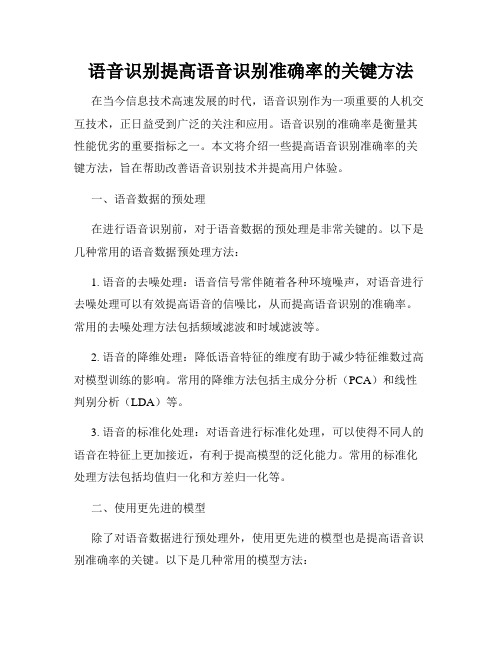
语音识别提高语音识别准确率的关键方法在当今信息技术高速发展的时代,语音识别作为一项重要的人机交互技术,正日益受到广泛的关注和应用。
语音识别的准确率是衡量其性能优劣的重要指标之一。
本文将介绍一些提高语音识别准确率的关键方法,旨在帮助改善语音识别技术并提高用户体验。
一、语音数据的预处理在进行语音识别前,对于语音数据的预处理是非常关键的。
以下是几种常用的语音数据预处理方法:1. 语音的去噪处理:语音信号常伴随着各种环境噪声,对语音进行去噪处理可以有效提高语音的信噪比,从而提高语音识别的准确率。
常用的去噪处理方法包括频域滤波和时域滤波等。
2. 语音的降维处理:降低语音特征的维度有助于减少特征维数过高对模型训练的影响。
常用的降维方法包括主成分分析(PCA)和线性判别分析(LDA)等。
3. 语音的标准化处理:对语音进行标准化处理,可以使得不同人的语音在特征上更加接近,有利于提高模型的泛化能力。
常用的标准化处理方法包括均值归一化和方差归一化等。
二、使用更先进的模型除了对语音数据进行预处理外,使用更先进的模型也是提高语音识别准确率的关键。
以下是几种常用的模型方法:1. 深度神经网络(DNN):DNN是一种由多个隐藏层组成的前向神经网络,通过逐层训练和叠加特征,可以有效提取语音数据的高阶特征。
DNN在语音识别领域取得了重要的突破,被广泛应用于声学模型的训练和建模。
2. 长短时记忆网络(LSTM):LSTM是一种特殊的循环神经网络,其通过引入门控单元解决了传统循环神经网络训练过程中的梯度消失和梯度爆炸问题。
LSTM在语音识别中具有良好的时间序列建模能力,能够有效地捕捉语音数据的时序特征。
3. 编码-解码模型(Encoder-Decoder):编码-解码模型是一种将输入序列映射到输出序列的神经网络模型。
在语音识别中,可以将语音输入映射到文本输出,从而实现语音转换为文字。
编码-解码模型具有强大的序列处理能力,能够有效应对语音识别中的时序问题。
音频处理中的语音识别算法使用方法和技巧

音频处理中的语音识别算法使用方法和技巧语音识别技术是人工智能领域的重要应用之一,已经广泛应用于语音助手、语音转文字等场景。
在音频处理中,语音识别算法起着关键作用,它能将人的口述语言转换成计算机可以理解和处理的文本。
本文将介绍语音识别算法的使用方法和技巧,帮助读者更好地应用于音频处理中。
一、语音识别算法的基本原理在了解语音识别算法的使用方法和技巧之前,我们首先需要了解其基本原理。
语音识别算法主要分为以下几个步骤:1. 预处理:对音频信号进行预处理,包括降噪、滤波等操作,以提高后续处理的准确性和稳定性。
2. 特征提取:将预处理后的音频信号转换成一系列特征向量,常用的特征提取方法包括MFCC(Mel频率倒谱系数)、PLP(Perceptual Linear Prediction)等。
3. 建模:将特征向量与预先训练好的声学模型进行比较,选择最可能的模型作为识别结果。
常用的声学模型包括隐马尔可夫模型(HMM)、深度神经网络(DNN)等。
4. 解码:将模型输出的概率序列转换成文本结果,常用的解码算法包括维特比算法、剪枝算法等。
二、语音识别算法的使用方法1. 数据准备:首先需要准备训练数据和测试数据。
训练数据应该包含大量的语音样本及其对应的文本标注,用于训练声学模型。
测试数据用于评估和验证模型的性能。
2. 特征提取:选择合适的特征提取方法进行特征提取,例如MFCC。
特征向量的维度和时间步长需要根据具体需求进行调整。
3. 建模训练:使用训练数据对声学模型进行训练。
常用的训练方法包括最大似然估计(MLE)和隐马尔可夫模型(HMM)的训练方法。
4. 解码生成:使用训练好的声学模型对测试数据进行解码生成文本。
可以采用维特比算法等解码算法进行解码。
5. 结果评估:对生成的文本结果与真实标注进行比较,计算准确率、召回率、F1值等指标,评估模型的性能。
三、语音识别算法的技巧1. 数据增强:通过对训练数据进行变速、变音调、加噪声等操作,扩充训练数据量,提高模型的泛化能力。
语音识别技术的使用技巧总结

语音识别技术的使用技巧总结随着科技的不断进步,语音识别技术逐渐渗透到我们日常生活的各个领域。
无论是智能助手、语音输入还是语音控制,语音识别技术都起到了重要的作用。
在这篇文章中,我们将总结一些使用语音识别技术的技巧,以帮助读者更好地应用该技术。
首先,要确保准确的发音。
语音识别技术依赖于准确的发音才能正确识别出语音内容。
因此,我们在使用时要尽量清晰地发音,避免语速过快或不清楚的发音。
如果我们的发音不标准或有口音,可以尝试使用更高级的语音识别技术,因为它们可以更好地适应不同的发音习惯。
其次,合理选择语音识别技术的设备或应用程序。
不同的设备或应用程序可能有不同的语音识别准确度和功能。
如果我们需要进行高准确度的语音识别,可以选择一些专业的语音识别软件或设备。
然而,如果我们只是偶尔使用语音识别,智能手机的内置语音助手已经能够满足大部分需求。
进一步,了解并熟练使用语音识别技术的功能。
语音识别技术不仅可以用于语音输入,还可用于语音控制和语音搜索等功能。
例如,我们可以通过语音指令控制智能家居设备,或是通过语音搜索查找想要的信息。
因此,当我们选择设备或应用程序时,需了解其提供的功能,并根据自己的需求进行选择。
此外,要注意语音识别技术在嘈杂环境中的准确度。
在噪声较大的环境下,语音识别技术可能会因为环境噪声而影响识别结果。
为了提高识别准确度,我们可以选择降噪功能较好的设备或应用程序,或是尝试在相对安静的环境下使用语音识别技术。
另外,通过训练模型来提高语音识别的准确度也是一个不错的选择。
一些高级语音识别技术支持自定义词汇和命令,可以根据个人或特定领域的需求进行训练。
通过录制特定的语音样本和提供对应的文字标签来训练模型,可以大幅提高语音识别的准确度和适应性。
此外,结合其他辅助输入方法能够更好地提高语音识别的使用效果。
虽然语音识别技术方便快捷,但有些情况下,我们可能需要结合其他输入方式来提高效率。
比如在长篇文本编辑时,除了使用语音输入外,我们还可以结合键盘输入进行快速编辑和修正。
语音识别方法简介

所以任何语音信号的分析和处理必须建
立在“短时”的基础上,即进行“短时分 析”,将语音信号分为一段一段来分析其 特征参数,其中每一段称为“一帧”,帧 长一般取为10-30ms。这样,对整体的语音 信号来讲,分析出的是由每一帧特征参数 组成的特征参数时间序列。
语音信号中含有丰富的信息,但如何从中提取 出对语音识别有用的信息呢?特征提取就是完成这 项工作,它对语音信号进行分析处理,去除对语音 识别无关紧要的冗余信息,获得影响语音识别的重 要信息。特征提取一般要解决两个问题,一个是从 语音信号中提取(或测量)有代表性的合适的特征 参数(即选取有用的信号表示)另一个是进行适当 的数据压缩。目前。语音识别技术中应用最流行的 特征参数是基于人的声道模型和听觉机理的LPCC, LPCMCC, MFCC 和ZCPA(语音的上升过零率和非线性 幅度)方法提取语音的特征参数。
语音识别技术两个发展方向
• 大词汇量连续语音识别系统,主要应用于计算机 的听写机,以及与电话网或者互联网相结合的语 音信息查询服务系统,这些系统都是在计算机平 台上实现的;
• 小型化、便携式语音产品的应用,如无线手机上 的拨号、汽车设备的语音控制、智能玩具、家电 遥控等方面的应用,这些应用系统大都使用专门 的硬件系统实现。
高了系统的抗噪声能力;
◆语音识别系统的分类方式及依据
• 根据对说话人的依赖程度可以分为特定人和非特 定人语音识别系统。
• 根据对说话人说话方式的要求,可以分为孤立字 (词)语音识别系统,连接字语音识别系统以及 连续语音识别系统。
• 根据词汇量大小,可以分为小词汇量、中等词汇 量、大词汇量以及无特征 参数一般构成一个矢量,因此语音特征量 是一个矢量序列。语音信号中提取出来的 矢量序列经过数据压缩后便成为语音的模 板。显然,特征的选取对识别效果至关重 要,选择的标准应尽量满足以下两个要求:
语音识别的方法

语音识别的方法随着科技的不断进步,语音识别技术也日益成熟。
语音识别是一种将人类语言转化为计算机可理解的文本或命令的技术,它在日常生活和工作中发挥着重要作用。
本文将介绍几种常见的语音识别方法。
一、基于模板匹配的语音识别方法基于模板匹配的语音识别方法是最早被使用的一种方法。
它首先通过录制一组特定人的语音样本,然后将这些样本作为模板存储在计算机中。
当输入的语音与模板进行比对时,计算机会通过匹配度来确定输入语音的内容。
这种方法的优点是简单易实现,但受限于模板数量和质量,对于不同人的语音识别效果可能存在一定的误差。
二、基于隐马尔可夫模型的语音识别方法隐马尔可夫模型(Hidden Markov Model,HMM)是一种统计模型,被广泛应用于语音识别领域。
HMM将语音信号看作是一个状态序列,通过计算状态转移概率、发射概率和初始概率,来确定最可能的状态序列,从而实现语音识别。
这种方法的优点是可以适应不同人的语音特点,提高了识别的准确性。
三、基于深度学习的语音识别方法近年来,随着深度学习技术的发展,基于深度学习的语音识别方法得到了广泛应用。
深度学习模型如循环神经网络(Recurrent Neural Network,RNN)和卷积神经网络(Convolutional Neural Network,CNN)等可以自动学习输入语音的特征表示,从而提高了语音识别的准确性。
此外,深度学习模型还可以通过大量的训练数据来提高泛化能力,使得语音识别在实际应用中更加可靠。
四、基于注意力机制的语音识别方法注意力机制是一种模仿人类注意力机制的方法,在语音识别中也得到了应用。
该方法通过在解码过程中动态选择与当前输入语音对应的上下文信息,从而提高了识别的准确性。
注意力机制能够有效地处理长时间依赖性和上下文信息,使得语音识别更加准确和流畅。
总结起来,语音识别的方法有基于模板匹配、基于隐马尔可夫模型、基于深度学习和基于注意力机制等。
这些方法在不同的场景和需求下各有优劣,可以根据具体情况选择合适的方法。
语音识别方法

语音识别方法语音特征提取将语音信号转换为特征向量,通过这些向量来进行语音相关任务的训练与识别。
语音识别对特征参数有如下要求:1. 能将语音信号转换为计算机能够处理的语音特征向量;2. 能够符合或类似人耳的听觉感知特性;3. 在一定程度上能够增强语音信号、抑制非语音信号;常用特征提取方法有如下几种:●LPC●声谱图●倒谱分析●MFCC (最常用)声谱图将一段连续的语音信号通过分帧、FFT、灰度映射转换为离散、低维的特征向量,框架图如下:声谱图表示法流程基本流程如下:(1)将一段语音做分帧处理,即将其剪切为一段段语音片段(20~50ms之间);(2)将每一帧的语音信号通过短时傅里叶变换(FFT)转为频域信号,得到每一帧的频谱图,如下图所示,横轴为频率、纵轴为当前频率对饮的能量值。
在实际使用中,频谱图有三种,即线性振幅谱、对数振幅谱、自功率谱(对数振幅谱中各谱线的振幅都作了对数计算,所以其纵坐标的单位是dB(分贝)。
这个变换的目的是使那些振幅较低的成分相对高振幅成分得以拉高,以便观察掩盖在低幅噪声中的周期信号);语音频谱图(3)将每一帧的频谱值映射为灰度图,灰度的深浅就代表了该频率段能量的大小,很黑的地方就是频谱图中的峰值(共振峰formants)。
倒谱分析倒谱就是一种信号的傅里叶变换经对数运算后再进行傅里叶反变换得到的谱。
倒谱分析的目标是:从语音频谱中得到它的频谱包络(连接所有共振峰值点的平滑曲线),它在语音识别中被广泛用于描述特征。
主要流程如下:1.将原语音信号经过傅里叶变换得到频谱:X[k]=H[k]E[k],只考虑幅度就是:|X[k]|=|H[k]||E[k] |;2.我们在两边取对数:log||X[k] ||= log ||H[k] ||+ log ||E[k] ||;3.再在两边取逆傅里叶变换得到:x[k]=h[k]+e[k]。
下面是一个语音的频谱图。
峰值就表示语音的主要频率成分,把这些峰值称为共振峰(formants),而共振峰就是携带了声音的辨识属性,用它就可以识别不同的声音。
语音识别系统的使用方法(七)

语音识别系统的使用方法一、语音识别系统的基本原理语音识别系统是一种通过计算机技术将语音信号转换为文本的系统。
其基本原理是将输入的语音信号通过麦克风等设备采集,然后经过数字化处理,最后通过模式匹配和语言模型等技术将其转换为文本。
语音识别系统的核心技术包括信号处理、模式识别和自然语言处理等方面。
二、使用语音识别系统的设备和环境要求使用语音识别系统需要一台配置合适的计算机或智能手机,并且配备麦克风等录音设备。
此外,使用语音识别系统的环境也要求比较安静,避免背景噪音干扰。
在使用语音识别系统时,用户要保持一定的距离,并且尽量保持清晰的发音,以提高识别准确度。
三、语音识别系统的使用方法1. 软件安装首先,用户需要在计算机或智能手机上安装相应的语音识别软件。
常见的语音识别软件包括微软的“语音识别”、苹果的“Siri”和谷歌的“语音搜索”等。
在安装软件时,需要根据操作系统的要求进行设置和权限获取。
2. 训练模型在安装完软件后,一些语音识别系统还需要进行语音模型的训练,以提高识别的准确度。
在训练模型时,用户需要按照软件提示进行一定数量的语音样本录制,然后系统会根据这些样本进行模型的训练和优化。
3. 语音输入使用语音识别系统时,用户需要打开相应的软件,并且点击语音输入按钮,开始讲话。
在讲话时,需要注意音量和语速的控制,以确保系统能够准确识别。
同时,用户还可以通过一些特定的指令来控制系统的操作,比如“停止录音”、“删除最后一句”等。
4. 语音命令除了语音输入外,语音识别系统还支持一些语音命令,比如“打开文件夹”、“发送邮件”等。
用户可以通过这些语音命令来完成一些常见的操作,提高工作效率。
在使用语音命令时,用户需要熟悉系统支持的指令,并且清晰地发音,以确保系统能够正确执行。
四、语音识别系统的优缺点语音识别系统的优点在于可以提高输入效率,尤其是在一些场景下,比如开车、做饭等无法使用键盘的情况下。
此外,语音识别系统还可以帮助一些语音障碍的人群进行文字输入。
语音识别技术中的说话人识别方法
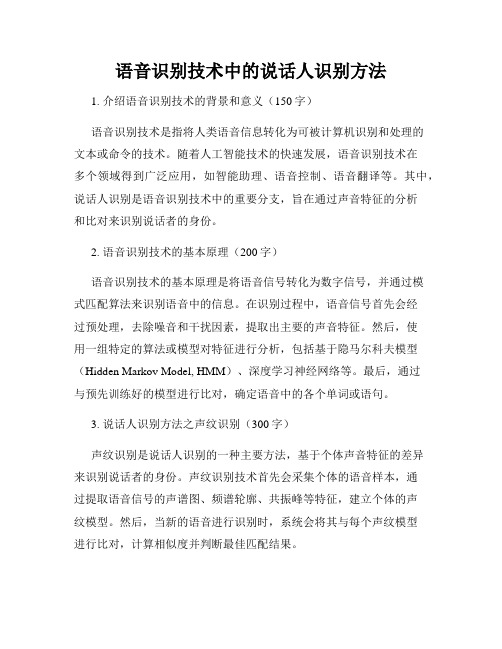
语音识别技术中的说话人识别方法1. 介绍语音识别技术的背景和意义(150字)语音识别技术是指将人类语音信息转化为可被计算机识别和处理的文本或命令的技术。
随着人工智能技术的快速发展,语音识别技术在多个领域得到广泛应用,如智能助理、语音控制、语音翻译等。
其中,说话人识别是语音识别技术中的重要分支,旨在通过声音特征的分析和比对来识别说话者的身份。
2. 语音识别技术的基本原理(200字)语音识别技术的基本原理是将语音信号转化为数字信号,并通过模式匹配算法来识别语音中的信息。
在识别过程中,语音信号首先会经过预处理,去除噪音和干扰因素,提取出主要的声音特征。
然后,使用一组特定的算法或模型对特征进行分析,包括基于隐马尔科夫模型(Hidden Markov Model, HMM)、深度学习神经网络等。
最后,通过与预先训练好的模型进行比对,确定语音中的各个单词或语句。
3. 说话人识别方法之声纹识别(300字)声纹识别是说话人识别的一种主要方法,基于个体声音特征的差异来识别说话者的身份。
声纹识别技术首先会采集个体的语音样本,通过提取语音信号的声谱图、频谱轮廓、共振峰等特征,建立个体的声纹模型。
然后,当新的语音进行识别时,系统会将其与每个声纹模型进行比对,计算相似度并判断最佳匹配结果。
声纹识别技术具有高度的个体特异性和稳定性,适用于长期身份认证等场景。
然而,声纹识别也面临环境干扰、可靠性差等问题,尚需进一步完善算法与模型训练。
4. 说话人识别方法之语音指纹识别(300字)语音指纹识别是另一种常用的说话人识别方法,它通过提取语音信号中的短时频率特征,将其转化为固定长度的语音指纹,再以此作为特征进行说话人识别。
语音指纹识别比较适用于短期身份认证和语音检索等应用场景。
语音指纹识别技术主要包括两个关键步骤:特征提取和匹配。
特征提取阶段会将语音信号转化为频域或时域特征,如梅尔频率倒谱系数(Mel Frequency Cepstral Coefficients, MFCC)或MFCC与动态时间规整(Dynamic Time Warping, DTW)等。
语音识别技术的使用方法与案例分析

语音识别技术的使用方法与案例分析随着科技的不断发展,语音识别技术在各行各业中越来越得到广泛的应用。
语音识别技术是指将人类语音输入转换为机器可以理解和处理的文字或命令的技术。
本文将介绍语音识别技术的使用方法以及一些成功的案例分析。
一、语音识别技术的使用方法1. 声学模型训练语音识别技术的第一步是声学模型的训练。
声学模型是基于大量的语音数据进行训练得到的,它可以理解不同人的发音差异并作出正确的识别。
使用者可以通过收集、标注和处理语音数据来建立自己的声学模型,也可以使用已经训练好的通用声学模型。
2. 语言模型构建语言模型是用于识别语音输入的文本部分的模型。
将已经处理好的语音数据和对应的文本进行统计和分析,可以得到一个语言模型。
语言模型可以帮助识别语音输入时的词序、语法和上下文信息,提高识别的准确性和可靠性。
3. 实时识别语音识别技术还可以实现实时识别。
通过将语音信号发送给识别系统,系统会实时分析语音特征并给出识别结果。
实时识别广泛应用于电话客服、语音助手和智能家居等领域。
4. 语音合成语音识别技术还可以应用于语音合成。
通过将文字转换为语音,可以实现自动语音提示、语音播报等功能。
语音合成技术在无人驾驶、导航系统等领域有着广泛的应用。
二、语音识别技术的案例分析1. 语音助手语音助手是一个非常成功的语音识别技术应用案例。
例如,手机的语音助手能够识别用户的语音指令,打开应用程序、发送短信、拨打电话等。
这使得用户可以通过语音与设备进行交互,提高了用户体验的便捷性。
2. 智能客服语音识别技术的应用还可以在客服领域发挥巨大的作用。
传统的客服通常需要用户通过按键选择功能或者文字输入问题,而语音识别技术的应用可以实现用户直接通过语音进行问题描述和解决方案的提供,实现了智能化、人性化的客服交互。
3. 自动语音转换文本语音识别技术也可以将语音转换为文字,实现自动化的语音转写。
这在会议记录、学习资料整理等场景中非常有用。
讲座课程、采访录音等语音资料可以通过语音识别技术自动转换为文字,减少了人工输入的工作量,提高了工作效率。
语音识别技术的使用技巧(Ⅱ)

语音识别技术的使用技巧随着科技的不断发展,语音识别技术已经成为我们日常生活中不可或缺的一部分。
从智能手机上的语音助手到智能家居设备,语音识别技术的应用越来越广泛。
在使用这项技术时,掌握一些使用技巧能够更好地提高识别准确性和效率。
一、清晰明了的发音和语速在使用语音识别技术时,清晰明了的发音是至关重要的。
尽量避免口齿不清或含糊不清的发音,这会影响语音识别的准确性。
此外,语速也是一个需要注意的因素。
不要过快地说话,也不要过慢,适中的语速可以帮助语音识别系统更好地捕捉和理解你的语音内容。
二、避免环境干扰和嘈杂声音在使用语音识别技术时,尽量选择一个相对安静的环境。
嘈杂的背景声音会干扰语音识别系统的工作,降低识别的准确性。
如果必须在嘈杂的环境下使用语音识别技术,可以考虑使用降噪麦克风或耳机,以减少环境干扰。
三、正确使用标点和语气表达在使用语音识别技术输入文字时,要注意使用正确的标点和语气表达。
语音识别系统通常能够识别并转换为相应的标点符号,但有时候需要特别强调的语气表达可能无法被准确识别。
因此,在语音输入结束后,可以适当检查和修改标点和语气表达,以确保文本的完整和准确。
四、适当的语音指令和操作习惯在使用语音识别技术的设备时,掌握一些常用的语音指令和操作习惯能够提高效率。
例如,在使用智能手机上的语音助手时,可以学会一些常用的指令,如“打开微信”、“发送短信给XX”等,以便更快地完成操作。
此外,了解设备的语音识别功能和操作界面也是很重要的,可以帮助更好地利用语音识别技术。
五、多维度的语音输入在使用语音识别技术时,不要局限于单一的语音输入方式。
除了输入文字外,还可以尝试使用语音输入进行搜索、控制设备、发送语音消息等功能。
这样不仅可以更好地发挥语音识别技术的优势,也能够提高使用效率。
六、定期更新和优化语音识别系统最后,定期更新和优化语音识别系统也是很重要的。
随着技术的不断进步,语音识别系统的性能也在不断提高,因此及时更新系统可以帮助提高识别准确性。
自动语音识别技术的使用技巧

自动语音识别技术的使用技巧自动语音识别(Automatic Speech Recognition,ASR)技术是一种将人类语音转换为文本的技术。
它广泛应用于语音转写、语音搜索和智能助理等领域。
本文将介绍一些使用自动语音识别技术的有效技巧,帮助您提高准确性和效率。
1. 确保清晰的录音环境在使用自动语音识别技术之前,确保录音环境是清晰的非常重要。
尽量避免噪音较多的环境,关闭背景音乐、关闭风扇或其他噪音源。
如果可能,可以选择在相对安静的地方进行录音,这样可以减少杂音对识别结果的干扰,提高识别的准确性。
2. 提高发音清晰度清晰的发音对于自动语音识别的准确性至关重要。
尽量准确地发音每个单词,注意音节的划分和重音的位置。
避免吞音和连音,尽量规范和稳定的发音,这样可以帮助识别系统更准确地理解你所说的话。
3. 使用简洁的语言和短句使用简洁的语言和短句可以帮助自动语音识别系统更好地理解您的意图。
避免使用过于复杂的句子结构和长篇大论的语言表达方式。
尽量使用简单明了的短句,这样可以提高识别的准确性和效率。
4. 注意语速和节奏语速和节奏的掌握对于自动语音识别的准确性和流畅性起着关键的作用。
语速过快会导致信息丢失,识别出错。
语速过慢会让自动语音识别系统产生长时间的等待响应,降低效率。
因此,要掌握适当的语速和节奏,避免过快或过慢的语音表达。
5. 修饰清晰的声音修饰清晰的声音可以提高自动语音识别的准确性。
清晰的声音不仅有助于自动语音识别系统更好地捕捉和解析语音,还可以避免发音模糊或不清晰造成的误识别。
因此,在录音时尽量保持清晰的声音,避免突然切换音量或语调。
6. 使用针对方言和口音的训练数据自动语音识别系统的准确性往往与训练数据的多样性有关。
一些方言和口音可能与标准语音存在差异,因此,选择使用针对方言和口音的训练数据可以提高识别的准确性。
这样可以减少方言或口音造成的识别错误,更好地适应不同的语音特点。
7. 及时纠正错误识别尽管自动语音识别技术在准确性方面有很大的进步,但仍然不可避免地会有一些错误的识别结果。
- 1、下载文档前请自行甄别文档内容的完整性,平台不提供额外的编辑、内容补充、找答案等附加服务。
- 2、"仅部分预览"的文档,不可在线预览部分如存在完整性等问题,可反馈申请退款(可完整预览的文档不适用该条件!)。
- 3、如文档侵犯您的权益,请联系客服反馈,我们会尽快为您处理(人工客服工作时间:9:00-18:30)。
2011年-2016年语音识别(SPEECH RECOGNITION)研究方法小结
说明:我从谷歌学术上以“SPEECH RECOGNITION”等关键词搜索最近5年国际上 发表的相关论文,对部分论文所采用的模型/方 法进行了非常简要的总结。
2011年
采用的模型/方法有: 1. The context-independent Deep Belief Network
4. Toth L. Combining time- and frequency-domain convolution in convolutional neural network-based phone recognition[C]// 2014:190-194.
5. Sainath T N, Kingsbury B, Saon G, et al. Deep Convolutional Neural Networks for Largescale Speech Tasks[J]. Neural Networks, 2015, 64:39-48.
1. Dahl G E, Dong Y, Li D, et al. Large vocabulary continuous speech recognition with context-dependent DBN-HMMS[C]// IEEE International Conference on Acoustics, Speech & Signal Processing. IEEE, 2011:4688-4691.Deep Belief Networks (DBNs)
2. Hannun A, Case C, Casper J, et al. Deep Speech: Scaling up end-to-end speech recognition[J]. Eprint Arxiv, 2014.
3. Chorowski J, Bahdanau D, Cho K, et al. End-to-end Continuous Speech Recognition using Attention-based Recurrent NN: First Results[J]. Eprint Arxiv, 2014.
in Convolutional Neural NetworБайду номын сангаасs(CNNs) 5. Deep Convolutional Neural Networks(CNNs) 6. Bi-Directional Recurrent DNNs
2014年
方法/模型对应的论文:
1. A. Graves, N. Jaitly. Towards end-to-end speech recognition with recurrent neural networks[C]// International Conference on Machine Learning. 2014:1764-1772.
2015年
采用的模型/方法有: 1. Sequence-to-Sequence Neural Net Models 2. Attention-based Recurrent Networks 3. Long Short-Term Memory (LSTM) recurrent neural
networks (RNNs)
3. Deng L, Tur G, He X, et al. Use of kernel deep convex networks and end-to-end learning for spoken language understanding[C]// Spoken Language Technology Workshop. 2012:210-215.
Networks(RNNs) 4. Deep Neural Networks(DNNs) (by substituting the
logistic units with rectified linear units.)
2013年
方法/模型对应的论文:
1. Graves, A, Mohamed, A.-R, Hinton, G. Speech recognition with deep recurrent neural networks[C]// 2013:257-264 vol.1.
2. Sainath T N, Kingsbury B, Ramabhadran B, et al. Making Deep Belief Networks effective for large vocabulary continuous speech recognition[C]// Automatic Speech Recognition and Understanding. IEEE, 2010:30-35.
6. Hannun A Y, Maas A L, Jurafsky D, et al. First-Pass Large Vocabulary Continuous Speech Recognition using Bi-Directional Recurrent DNNs[J]. Eprint Arxiv, 2014.
2015年
方法/模型对应的论文:
1. Yao K, Zweig G. Sequence-to-Sequence Neural Net Models for Grapheme-to-Phoneme Conversion[J]. Computer Science, 2015.
2. Chorowski J, Bahdanau D, Serdyuk D, et al. Attention-Based Models for Speech Recognition[J]. Computer Science, 2015.
2013年
采用的模型/方法有: 1. Deep Recurrent Neural Networks(RNNs) 2. Deep Convolutional Neural Networks(CNNs) 3. Deep Bidirectional LSTM (DBLSTM) Recurrent Neural
3. A)Rao K, Peng F, Sak H, et al. Grapheme-to-phoneme conversion using Long Short-Term Memory recurrent neural networks[C]// IEEE International Conference on Acoustics, Speech and Signal Processing. IEEE, 2015.
3. B)Haşim Sak, Andrew Senior, Kanishka Rao, et al. Fast and Accurate Recurrent Neural Network Acoustic Models for Speech Recognition[J]. Computer Science, 2015.
Neural Nets and Kernel Acoustic Models for Speech Recognition[J]. Respiratory Physiology & Neurobiology, 2016, 161(2):214-7.
2012年
采用的模型/方法有: 1. Deep Neural Networks(DNNs) 2. Deep Belief Networks(DBNs), neural networks 3. Kernel deep convex networks
2012年
方法/模型对应的论文:
1. Hinton G, Deng L, Yu D, et al. Deep Neural Networks for Acoustic Modeling in Speech Recognition[J]. IEEE Signal Processing Magazine, 2012, 29(6):82 - 97.
3. B)Dahl G E, Yu D, Deng L, et al. Context-Dependent Pre-trained Deep Neural Networks for Large Vocabulary Speech Recognition[J]. IEEE Transactions on Audio Speech & Language Processing, 2012, 20(1):30 - 42.
4. Zeiler, M.D, Ranzato M, Monga R, et al. On rectified linear units for speech processing[J]. 2013, 32(3):3517-3521.
2014年
采用的模型/方法有: 1. LSTM Recurrent Neural Networks(RNNs) 2. A well-optimized RNN training system 3. Attention-based RNN 4. Combining time and frequency-domain convolution
2. Sainath T N, Mohamed A R, Kingsbury B, et al. Deep convolutional neural networks for LVCSR[J]. 2013:8614-8618.
